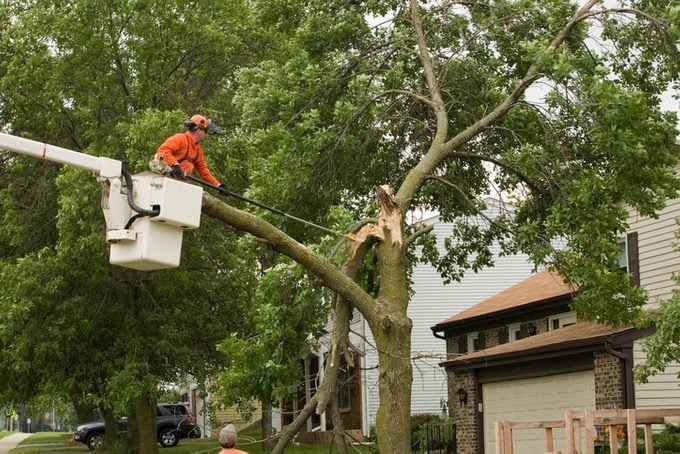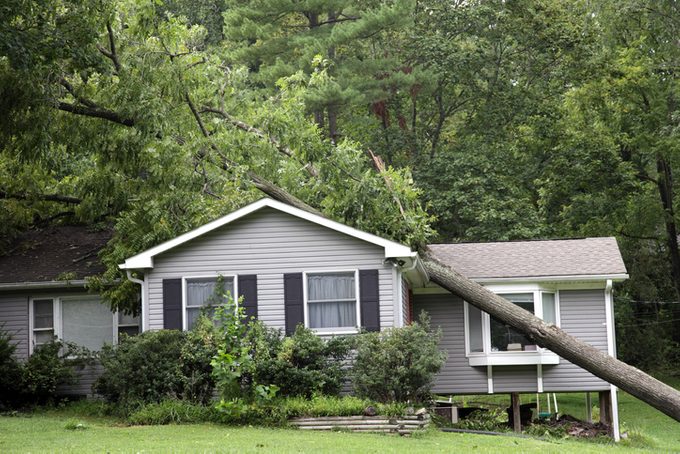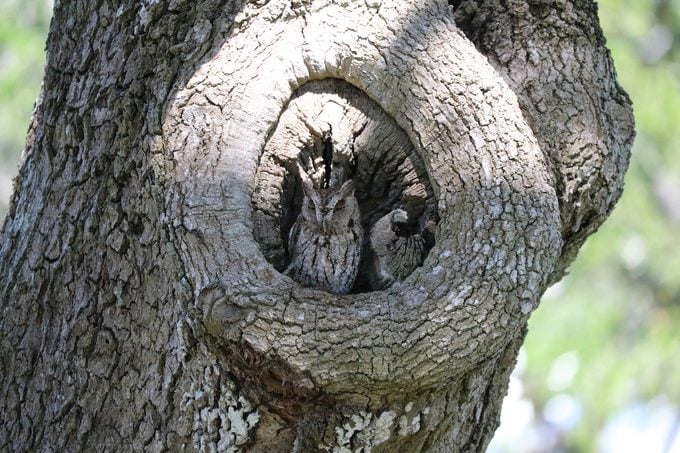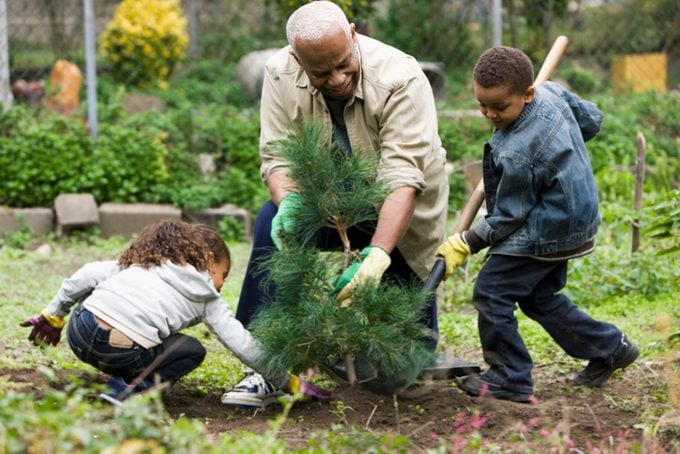How to Repair and Care for Storm Damaged Trees
Updated: Dec. 17, 2021
Summer thunderstorms can knock down limbs or whole trees. Learn how to handle tree storm damage and when to call an arborist for help.

Summer storms or heavy wind and ice often damage trees across the country. Homeowners need to know the best ways to clean up after a tree is damaged and how to restore trees in their communities. From watching the light flicker through a tree’s green canopy in summer to enjoying the falling cascade of red, yellow, and brown leaves in the fall, trees enrich our lives in many ways. Storms can damage or destroy long-living trees and the memories they carry with them. Here’s what you need to know about tree storm damage.
What Happens After a Storm Damages Trees?
When a tree is damaged by a storm, tornado, hurricane, or another type of disturbance, it not only affects the immediate area, but also the surrounding trees.
“Trees are usually very resilient to damage,” says University of Illinois Extension horticulture educator Ryan Pankau. “But when a storm or disease takes out parts of a tree, it exposes the other trees in the area differently, and you may see damage to them years down the line.”
After a disturbance, sunlight can now reach the understory. This exposes the soil and creates opportunities for new plants to fill those gaps. Those gaps can be filled by younger trees or plants, but also by less desirable plants, such as invasive weedy species. And, a thinning tree canopy from storm damage can reduce a tree’s capacity to filter wind.
“Trees with thicker canopies act like a sail during high winds,” says Christopher Enroth, Illinois Extension horticulture educator. “But when thinned, small, new branches have a very weak attachment to the tree itself, making it less stable overall.”
Check out the best types of evergreen trees and how to care for them.

How Should Homeowners Respond to Tree Storm Damage?
After the storm has passed, make sure the area is safe. Avoid areas with downed power lines, as they may still be active and are very dangerous.
The first thing to do is clear out the obvious broken, hanging limbs. Then, look at the angle of the leaves on branches still attached to the tree. They will give away tree limbs that might be broken and could fall later.
“The next course of action is to have a tree care professional or a certified arborist assess the damage,” says University of Illinois Extension Extension Forester Chris Evans. “They’ll make sure no pathogens have leeched into the trees after they’ve been damaged and to properly prune them.”
Pruning cuts off any stubs or chunks off a broken limb to seal the wood and help avoid rot that can slowly kill a tree over time.
“Trees don’t heal, they seal,” says Pankau. “Trees don’t regenerate tissues like humans. They will just grow around the wound and lock it into itself.”
Find a list of certified arborists at Treesaregood.org and search by zip code.
Check out the top 10 quick growing trees for your landscape.
What to Ask an Arborist About Storm Damaged Trees
Every summer, Extension offices get calls about trees after a storm. Here are some common concerns:
- Despite the storm damage, is the tree healthy with good growth?
- Did the trunk experience significant damage? The vascular tissue of a tree resides directly behind the bark. If this critical tissue is severed, a tree cannot move water and nutrients through its system.
- Are major limbs broken? The larger the lost limb, the harder it will be for the tree to seal off that wound.
- Is the tree desirable, or is it prone to problems? Sometimes storms present opportunities to replace a problem tree.
- Is the overall shape of the tree still intact? For instance, if a white pine loses the central leader, the tree will lose its pyramidal shape and become a hazard in the future.
Discover 8 types of Christmas trees you can grow.

How to Prevent Tree Storm Damage
Rural areas
In a forested setting, trees provide stable ecosystems and create habitats for all types of wildlife, including squirrels and cavity nesting birds. A healthy forested area needs to have a wide diversity of tree species. This is also important to follow the recommended stocking rate, or density of a forest. This stops undesirable trees from growing in the understory. Try these alternatives to invasive shrubs.
“Since you can’t go out and prune every tree on your property, it’s important to remove overcrowding and invasive species so you can achieve a healthy, flourishing ecosystem and provide habitats for critical organisms,” says Evans. These efforts not only keep a forest healthy, but also strengthen the woodland’s resilience against disturbances.
Urban areas
Trees are meant to grow near other trees and not individually like most urban settings. To maintain the health of trees, it pays to have a certified arborist inspection done every few years to make needed pruning cuts. To prevent damage, arborists can also apply cables and bolts.
“However, with enough wind and enough force, no amount of pruning or inspection is going to stop that tree from coming down in a bad enough storm,” says Pankau. “Still, arborists can sure stack the odds in your favor.”
Here’s the top 10 trees and shrubs with berries for birds.
Why Should You Replace Trees?
When trees are knocked down, it can change a community. Wildlife no longer has a place to nest, children lose a place to play, and homes are no longer shaded from the summer heat.
Trees provide a lot of unappreciated services in the background. They create habitat for insects, birds, and other native wildlife, and take up water which reduces flooding. They also increase air quality and trap carbon dioxide, a greenhouse gas, to slow the rate of global warming. In the warmer months, trees that shade homes will reduce energy bills and in the winter months, bare branches allow sunlight to heat homes.
Of all green spaces, trees seem to have a special impact on people’s mental health. Research from University of Illinois has found that when people have experiences with nature, they’re healthier, happier, learn better, and have stronger social ties. Green spaces are also tied to lower rates of depression and anxiety disorders.
“We, as humans, are meant to be in nature. When you put us in an environment that takes it away, we behave and feel badly,” says Pankau.
Psst—don’t miss these amazing nature photos.
How to Select New Trees
“The most important thing to consider when replanting trees after a storm is diversity,” says Evans.
Planting a variety of new trees, especially native trees, recreates a natural ecosystem, and leads to fewer pest issues, diseases, and invasive species.
Replacing damaged trees with native ones will add to the biodiversity of that area, letting insects, birds, and other organisms flourish in a healthier ecosystem. A study published in the journal Ecological Entomology in 2020 found the displacement of native plant communities is the main cause of a collapse in insect and bird populations around the world. To see if a tree is native, check at the USDA-approved hardiness zones located on the plant tag or online at planthardiness.ars.usda.gov.
Research specific species to see if it would be a good fit for your landscape and ask a certified arborist for verification. Some species, such as oak trees, have a competitive advantage. Compared to shady beech and maple trees, oak trees will take 40% to 60% of the available sunlight to compete with other plants and leave other species to die off.
Follow these 5 essential steps for tree planting success.





















